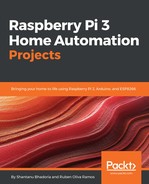In this book, you will find a number of text styles that distinguish between different kinds of information. Here are some examples of these styles and an explanation of their meaning. Code words in the text, database table names, folder names, filenames, file extensions, pathnames, dummy URLs, user input, and Twitter handles are shown as follows: "Make sure your Raspberry Pi is updated and upgraded. You can do this by typing sudo apt-get update && sudo apt-get upgrade".
A block of code is set as follows:
{
module: 'module name',
position: 'position',
header: 'optional header',
config: {
extra option: 'value'
}
},
When we wish to draw your attention to a particular part of a code block, the relevant lines or items are set in bold:
{
module: 'module name',
position: 'position',
header: 'optional header',
config: {
extra option: 'value'
}
},
Any command-line input or output is written as follows:
wget http://node-arm.herokuapp.com/node_latest_armhf.deb
sudo dpkg –i node_latest_armhf.deb
New terms and important words are shown in bold.
Warnings or important notes appear like this.
Tips and tricks appear like this.
